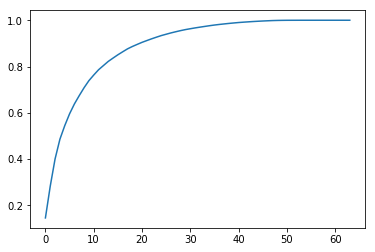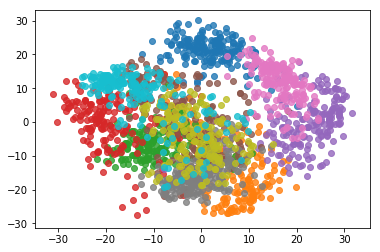PCA和梯度法
核心思想
其实严格来说,梯度下降法不是机器学习算法,是一种基于搜索的最优方法。
主要作用是最小化一个损失函数。相对应的,梯度上升法就是最大化一个效用函数。
关于梯度下降算法的直观理解,我们以一个人下山为例。按照梯度下降算法的思想,它将按如下操作达到最低点:
第一步,明确自己现在所处的位置
第二步,找到相对于该位置而言下降最快的方向
第三步, 沿着第二步找到的方向走一小步,到达一个新的位置,此时的位置肯定比原来低
第四部, 回到第一步
第五步,终止于最低点
scikit-learn中使用PCA
1
2
3
| import numpy as np
import matplotlib.pyplot as plt
from sklearn import datasets
|
1
2
3
| digits = datasets.load_digits()
X = digits.data
y = digits.target
|
1
2
3
| from sklearn.model_selection import train_test_split
X_train, X_test, y_train, y_test = train_test_split(X, y, random_state=666)
|
(1347, 64)
1
2
3
4
5
6
| %%time
from sklearn.neighbors import KNeighborsClassifier
knn_clf = KNeighborsClassifier()
knn_clf.fit(X_train, y_train)
|
CPU times: user 19.9 ms, sys: 7.47 ms, total: 27.4 ms
Wall time: 64.5 ms
1
| knn_clf.score(X_test, y_test)
|
0.98666666666666669
1
2
3
4
5
6
| from sklearn.decomposition import PCA
pca = PCA(n_components=2)
pca.fit(X_train)
X_train_reduction = pca.transform(X_train)
X_test_reduction = pca.transform(X_test)
|
1
2
3
| %%time
knn_clf = KNeighborsClassifier()
knn_clf.fit(X_train_reduction, y_train)
|
CPU times: user 2.13 ms, sys: 767 µs, total: 2.9 ms
Wall time: 2.93 ms
1
| knn_clf.score(X_test_reduction, y_test)
|
0.60666666666666669
主成分所解释的方差
1
| pca.explained_variance_ratio_
|
array([ 0.14566817, 0.13735469])
array([ 175.77007821, 165.73864334])
1
2
3
4
5
| from sklearn.decomposition import PCA
pca = PCA(n_components=X_train.shape[1])
pca.fit(X_train)
pca.explained_variance_ratio_
|
array([ 1.45668166e-01, 1.37354688e-01, 1.17777287e-01,
8.49968861e-02, 5.86018996e-02, 5.11542945e-02,
4.26605279e-02, 3.60119663e-02, 3.41105814e-02,
3.05407804e-02, 2.42337671e-02, 2.28700570e-02,
1.80304649e-02, 1.79346003e-02, 1.45798298e-02,
1.42044841e-02, 1.29961033e-02, 1.26617002e-02,
1.01728635e-02, 9.09314698e-03, 8.85220461e-03,
7.73828332e-03, 7.60516219e-03, 7.11864860e-03,
6.85977267e-03, 5.76411920e-03, 5.71688020e-03,
5.08255707e-03, 4.89020776e-03, 4.34888085e-03,
3.72917505e-03, 3.57755036e-03, 3.26989470e-03,
3.14917937e-03, 3.09269839e-03, 2.87619649e-03,
2.50362666e-03, 2.25417403e-03, 2.20030857e-03,
1.98028746e-03, 1.88195578e-03, 1.52769283e-03,
1.42823692e-03, 1.38003340e-03, 1.17572392e-03,
1.07377463e-03, 9.55152460e-04, 9.00017642e-04,
5.79162563e-04, 3.82793717e-04, 2.38328586e-04,
8.40132221e-05, 5.60545588e-05, 5.48538930e-05,
1.08077650e-05, 4.01354717e-06, 1.23186515e-06,
1.05783059e-06, 6.06659094e-07, 5.86686040e-07,
7.44075955e-34, 7.44075955e-34, 7.44075955e-34,
7.15189459e-34])
1
2
3
| plt.plot([i for i in range(X_train.shape[1])],
[np.sum(pca.explained_variance_ratio_[:i+1]) for i in range(X_train.shape[1])])
plt.show()
|

1
2
| pca = PCA(0.95)
pca.fit(X_train)
|
PCA(copy=True, iterated_power='auto', n_components=0.95, random_state=None,
svd_solver='auto', tol=0.0, whiten=False)
28
1
2
| X_train_reduction = pca.transform(X_train)
X_test_reduction = pca.transform(X_test)
|
1
2
3
| %%time
knn_clf = KNeighborsClassifier()
knn_clf.fit(X_train_reduction, y_train)
|
CPU times: user 4.21 ms, sys: 1.28 ms, total: 5.49 ms
Wall time: 19.7 ms
1
| knn_clf.score(X_test_reduction, y_test)
|
0.97999999999999998
使用PCA对数据进行降维可视化
1
2
3
| pca = PCA(n_components=2)
pca.fit(X)
X_reduction = pca.transform(X)
|
1
2
3
| for i in range(10):
plt.scatter(X_reduction[y==i,0], X_reduction[y==i,1], alpha=0.8)
plt.show()
|



